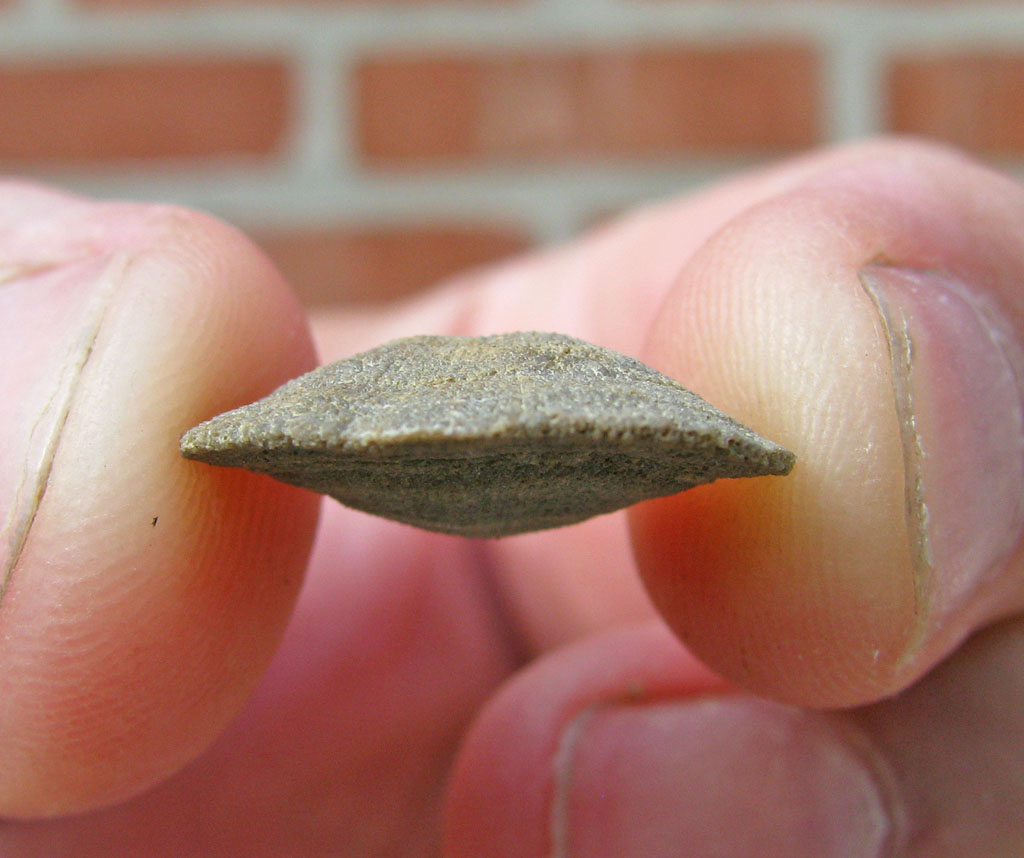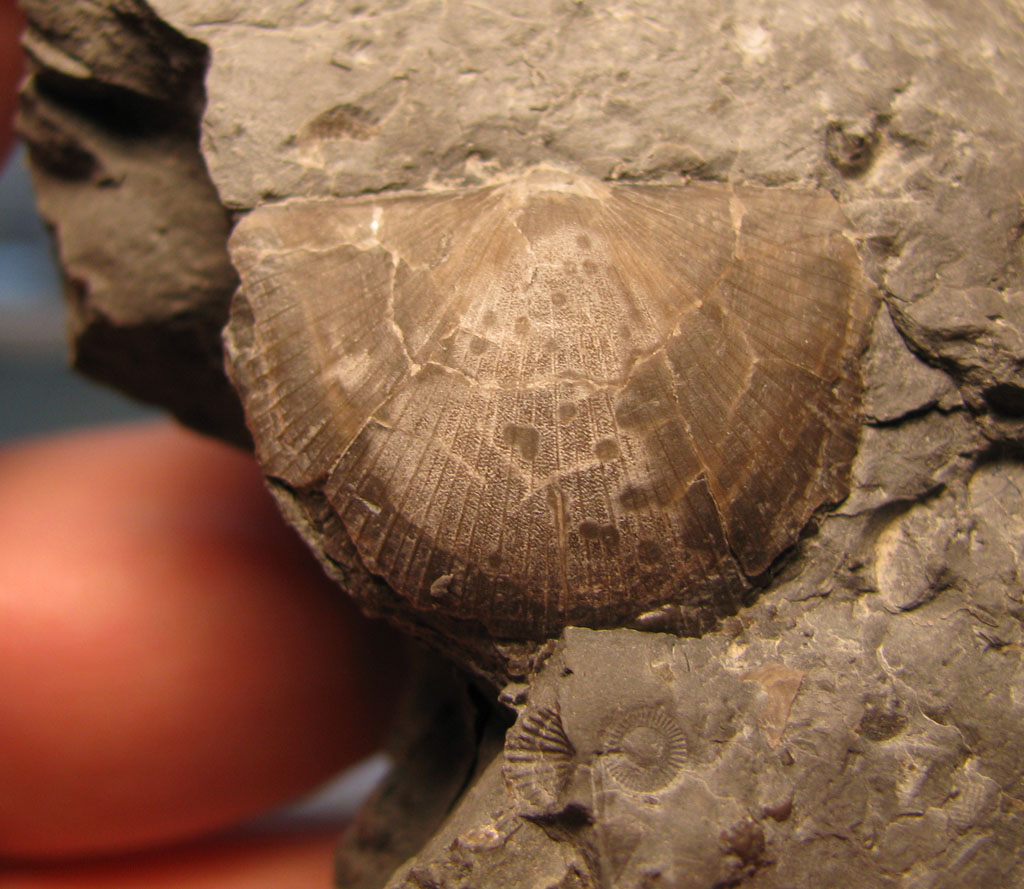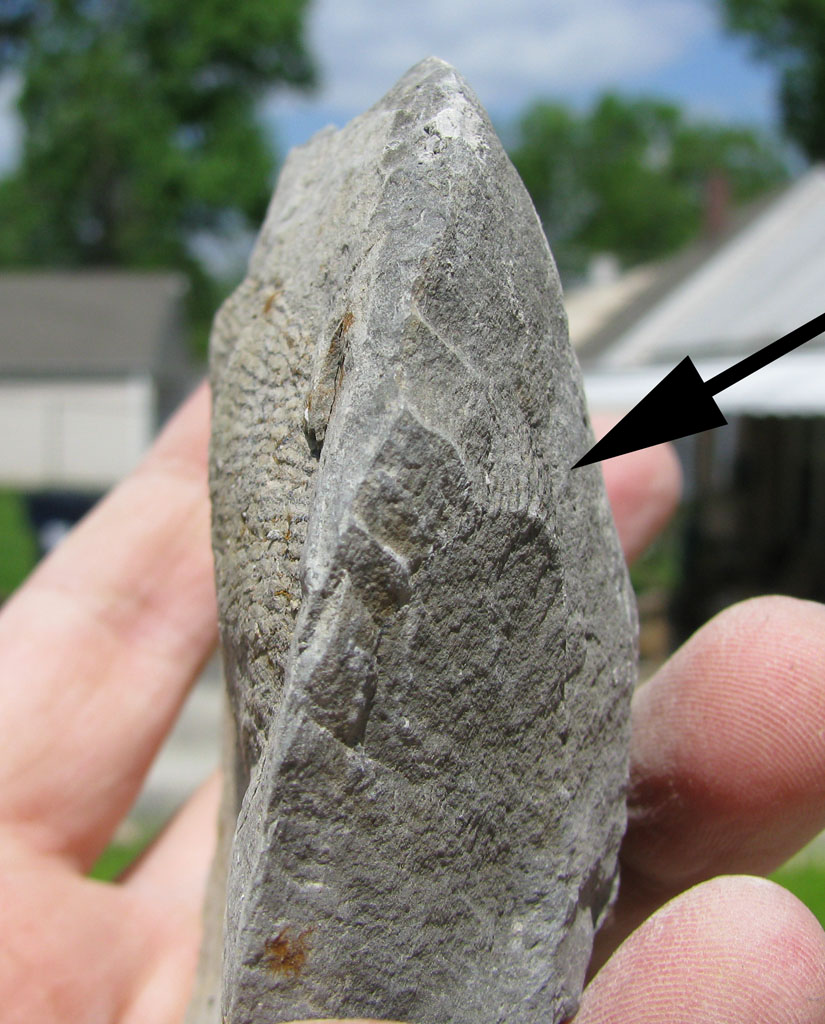The other common species of Rhipidomella is R. penelope. It tends to grow larger and have a rounder shell than R. vanuxemi. The specimen below came from the Bay View Coral Bed within the Windom Shale at the Penn Dixie site near Blasdell, NY. It's rare to find a fully inflated specimen and even this one is only partially inflated.
Pedicle valve
Anterior
Pedicle valve
Posterior
Profile
The Windom shale is part of the Moscow Formation which is part of the Givetian stage of the Upper Devonian.
Monday, June 30, 2014
Saturday, June 28, 2014
Rhipidomella vanuxemi brachiopod from the Centerfield member
One of the two main species of the Rhipidomella genus found in the middle Devonian is Rhipidomella vanuxemi. It's fairly common and can be distinguished from the similar species R. penelope as it is typically smaller in size and the shape of the shell is less ovate. The fossil below is partially replaced by Quartz which is why the shell has some gray (Calcite) and white (Quartz) patches. It was found in the Centerfield member of the Ludlowville formation and is fairly common.
Brachial valve
Anterior
Pedicle valve
Posterior
Profile
Here is a second specimen which has a rare predation hole in the pedicle valve.
Brachial valve
Anterior
Pedicle valve
Closer view of the hole
Posterior
Profile
The Centerfield mbr. of the Ludlowville formation records a portion of the Givetian stage of the Devonian period.
Brachial valve
Anterior
Pedicle valve
Posterior
Profile
Here is a second specimen which has a rare predation hole in the pedicle valve.
Brachial valve
Anterior
Pedicle valve
Closer view of the hole
Posterior
Profile
The Centerfield mbr. of the Ludlowville formation records a portion of the Givetian stage of the Devonian period.
Thursday, June 26, 2014
Eosyringothyris sp. brachiopod from Fayette, NY
This is one of the more unusual brachiopods that I've found in New York. It came from a small quarry near Fayette, NY that exposes a portion of the Centerfield member of the Ludlowville Formation. The fossil looks like a very large Cyrtina type brachiopod as it has a deep pedicle valve and a large interarea.
Brachial valve
Anterior
Pedicle valve
Posterior - Note the large delthyrium (upside down triangle shape) in the middle of the interarea
Profile
Via a posting on the Fossil Forum I was able to get an ID for this brachiopod from a member named Gerry. He identified it as an Eosyringothyris which is rare and undescribed in New York but is slightly more common at the location where I found my specimen. Another member sent me a paper from the Journal of Paleontology (Merrill A. Stainbrook, 1943, Spiriferacea of the Cedar Valley Limestone of Iowa: Vol 17, No. 5, pg. 417-450) which has specimens of Eosyringothyris illustrated. In that paper they have a species called E. triangularis that looks very similar to the specimen I found.
The rock of the Centerfield member at the Fayette town quarry is more argillaceous (shale like) than portions found father west and the fossils are not preserved by quartz as often. This is because the area the rocks were deposited in was closer to the shore and therefore the rivers that carried sediment off the mountains farther east. The Ludlowville formation is Devonian (Givetian stage) in age.
Brachial valve
Anterior
Pedicle valve
Posterior - Note the large delthyrium (upside down triangle shape) in the middle of the interarea
Profile
Via a posting on the Fossil Forum I was able to get an ID for this brachiopod from a member named Gerry. He identified it as an Eosyringothyris which is rare and undescribed in New York but is slightly more common at the location where I found my specimen. Another member sent me a paper from the Journal of Paleontology (Merrill A. Stainbrook, 1943, Spiriferacea of the Cedar Valley Limestone of Iowa: Vol 17, No. 5, pg. 417-450) which has specimens of Eosyringothyris illustrated. In that paper they have a species called E. triangularis that looks very similar to the specimen I found.
The rock of the Centerfield member at the Fayette town quarry is more argillaceous (shale like) than portions found father west and the fossils are not preserved by quartz as often. This is because the area the rocks were deposited in was closer to the shore and therefore the rivers that carried sediment off the mountains farther east. The Ludlowville formation is Devonian (Givetian stage) in age.
Tuesday, June 24, 2014
Favosites hamiltoniae from the Centerfield member
Here is a nice palm sized colony of Favosites hamiltoniae that I found in the Centerfield mbr. of the Ludlowville formation near East Bethany. It is partially replaced by Quartz which is why it has a sort of patchy look on the dorsal surface. Some of the corallites are missing while others have some nice detail preserved of the septal spines.
Dorsal surface
Ventral surface... the epitheca is very well preserved with just a few missing pieces.
Side profiles
Close up of the dorsal surface where you can see some of the septal spines.
The Centerfield mbr. of the Ludlowville formation records a portion of the Givetian stage of the Devonian period.
Dorsal surface
Ventral surface... the epitheca is very well preserved with just a few missing pieces.
Side profiles
Close up of the dorsal surface where you can see some of the septal spines.
The Centerfield mbr. of the Ludlowville formation records a portion of the Givetian stage of the Devonian period.
Sunday, June 22, 2014
Favosites argus tabulate coral from the Centerfield Member
Occasionally I come across large coral colonies while digging in the eroded remains of the Centerfield mbr. of the Ludlowville Formation near East Bethany, NY. The specimen below is fairly large at approximately 8" across by 4" wide. I think this is a colony of Favosites argus because of the small cell size of the corallites.
Dorsal surface
Profile
Ventral surface
Ventral surface detail
Dorsal surface details.
The Centerfield member of the Ludlowville formation is dated to the middle Devonian (Givetain stage).
Dorsal surface
Profile
Ventral surface
Ventral surface detail
Dorsal surface details.
The Centerfield member of the Ludlowville formation is dated to the middle Devonian (Givetain stage).
Friday, June 20, 2014
Strophodonta demissa from Penn Dixie
A few specimens of Strophodonta demissa from the Windom Shale (Bay View Coral Bed) as found at the Penn Dixie Site near Blasdell, NY. These are smaller than the specimen I found along Lake Erie and those from Sylvania, OH, but are about the size of those I've found at Arkona.
Specimen #1 (wet because I'd just washed off some light mud)
Specimen #2 (this one is completely dry)
The Windom shale is part of the Moscow Formation which is middle Deovnian (Givetian stage) in age.
Specimen #1 (wet because I'd just washed off some light mud)
Specimen #2 (this one is completely dry)
The Windom shale is part of the Moscow Formation which is middle Deovnian (Givetian stage) in age.
Labels:
Blasdell,
Brachiopod,
Devonian,
New York,
Penn Dixie
Wednesday, June 18, 2014
Dipleura dekayi pygidium from the Windom Shale
At the Penn Dixie site, near Blasdell NY, it is very common to find Phacops rana trilobites and sometimes Greenops sp. trilobites. One of the more rare trilboites to be found there is Dipleura and when you do find them it's often just isolated pieces. Such is the case with the specimen below of a pygidium from a Dipleura dekayi. The fossil is very smooth despite all the dots that you can see on the surface. I'm used to finding specimens of D. dekayi in my local Mahantango formation that don't have any shell material left and the dots are preserved as small columns. This indicates that they served some purpose in life, perhaps as sensory organs?
This specimen was found in the Bay View Coral Bed in the Windom Shale of the Moscow Formation (Devonian, Givetian stage).
This specimen was found in the Bay View Coral Bed in the Windom Shale of the Moscow Formation (Devonian, Givetian stage).
Monday, June 16, 2014
Spinocyrtia granulosus brachiopod from Arkona
This is a partial pedicle valve of Spinocyrtia granulosus that I found at Hungry Hollow near Arkona, ON recently. It's very large and is the only specimen that I have of this species from the Hungry Hollow member of the Widder formation (Devonian, Givetian stage).
Note the bryozoan holdfast
Note the bryozoan holdfast
Saturday, June 14, 2014
Dictyonema hamiltoniae graptolite from the Windom Shale
Graptolites are extinct creatures that were similar to coral or bryozoans in that they filtered the water for food particles and lived colonially. Below are some Graptolites from the Devonian aged Windom Shale (part of the Moscow Formation and Givetian stage) of New York that I recently found. I've only found graptolites before in Ordovician aged rocks and was very surprised when I was splitting shale and found these. They are a species called Dictyonema hamiltoniae and were found in the same beds that commonly produce Trilobites.
Specimen #1 - This specimen has both the part and counterpart with the Graptolite.
Part
A view at the bottom of the Part piece that shows the graptolite is preserved in three dimensions. The arrow in the picture below is pointing to a partially exposed piece of the graptolite that I believe is part of the same colony as the front side.
Counterpart
Closer view of the graptolite. Unfortunately there is not a whole lot of detail to be observed. Most times graptolites are just carbon films on the surface of the rock. This is what sets them apart from corals and bryozoans who use calcium carbonate (CaCO3) to construct their colonies
Specimen #2
Both specimens were found in Fall Brook near Geneseo, NY.
Specimen #1 - This specimen has both the part and counterpart with the Graptolite.
Part
A view at the bottom of the Part piece that shows the graptolite is preserved in three dimensions. The arrow in the picture below is pointing to a partially exposed piece of the graptolite that I believe is part of the same colony as the front side.
Counterpart
Closer view of the graptolite. Unfortunately there is not a whole lot of detail to be observed. Most times graptolites are just carbon films on the surface of the rock. This is what sets them apart from corals and bryozoans who use calcium carbonate (CaCO3) to construct their colonies
Specimen #2
Both specimens were found in Fall Brook near Geneseo, NY.
Subscribe to:
Posts (Atom)



















































